Hello and welcome back to the second part of my dive into my custom Magic set, Age of Sencora—a set originally meant to be top-down fairy tales and thus, timely to Wizards’ announcement of their Fall set, Throne of Eldraine.
Last time we went over some of the influences for the set, where the lore developed from, and the mechanics I ultimately built the set around. This week, I wanted to cap off this run of discussion on the set by looking at the archetypes I’ve built into the set for when it is drafted, talk about the planeswalkers, the importance of playtesting and how I learned to kill my darlings for the betterment of the set.
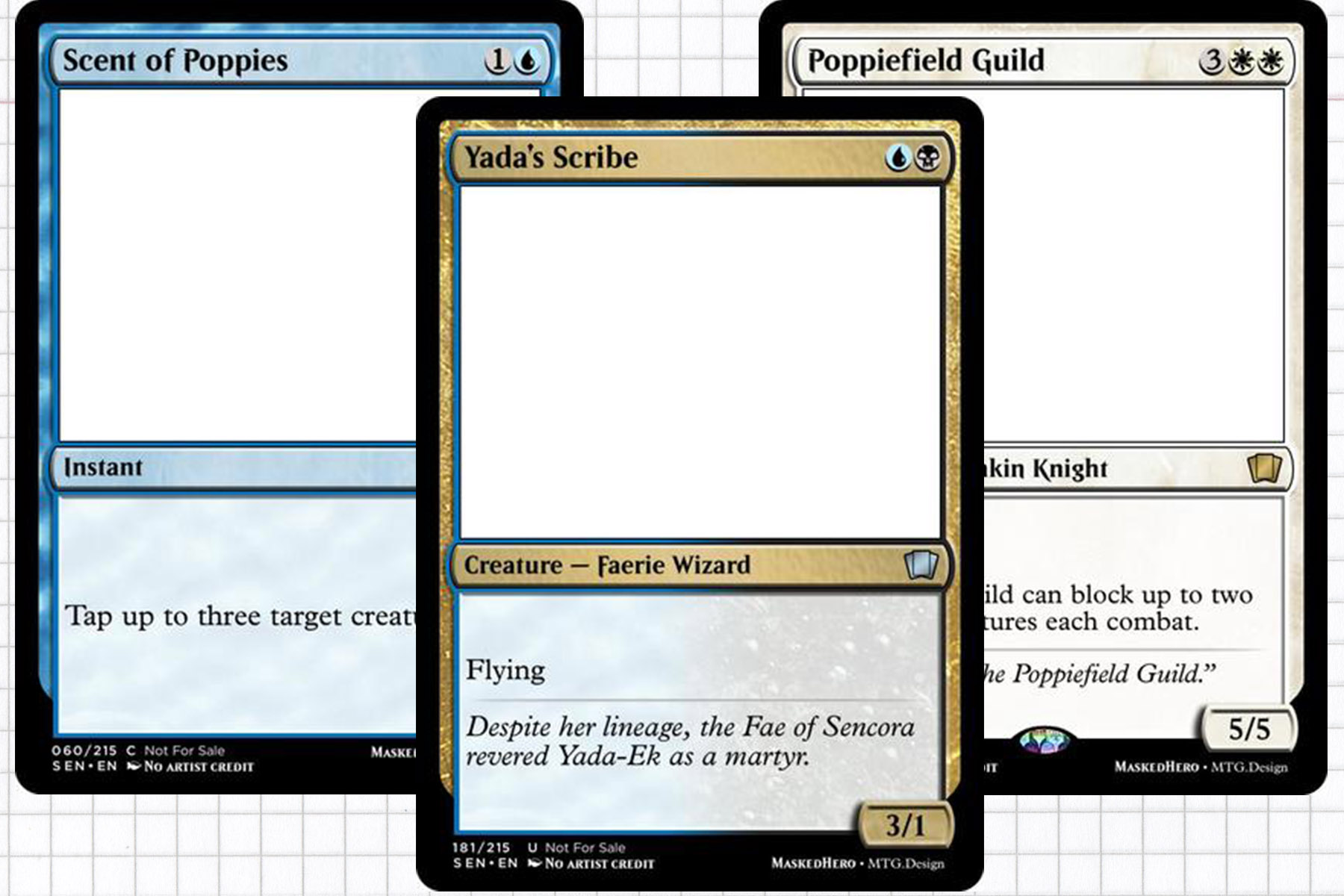
For a frame of reference and some context for my designs, let’s start by brief outlining what each color pair has been designed around. A good chunk of the tribal aspects of the set sit in the allied colored pairs. Except for White/Blue, which is looking to use spells to tap down enemy creatures, while stringing together a few creatures to close out games. Blue/Black is Faerie tribal, creating tokens and using lord effects to win with a board of fliers. Black/Red is looking to use Dwarf tribal and by extension some equipment themes to aggressively win. Red/Green similarly is Wolf tribal, which curves out a little higher and has longevity through its ability to fight back against artifacts. Rounding things out, Green/White gives us the return of Kithkin tribal, also creating tokens and intending to go wide. Of course, woven into these tribes in the ability to also fold into the enemy aligned pairs.
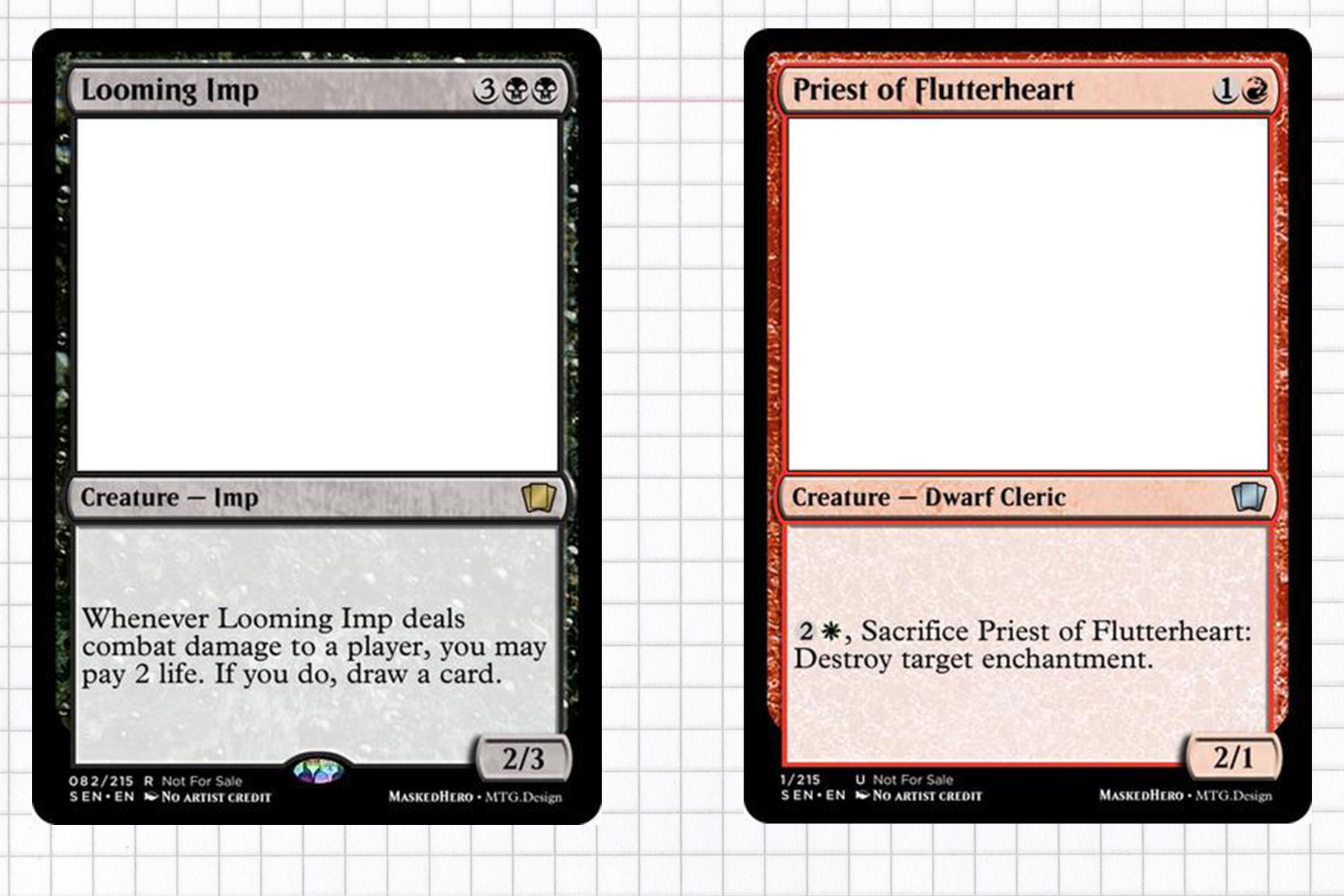
As enemy aligned pairs go, White/Black plays a strategy looking to stabilize the game with lifegain and bleed opponents over multiple turns. Blue/Red is the typical spell-based deck, but with the added layer of using Dilemma to help set up the bottom of its library for some of it’s higher rarity spells. Black/Green plays a Expanses-matter strategy, benefitting of the land subtype being played to enhance their spells. Red/White has the strongest overall theme for Conform, a midrange deck looking to have a wide board that all share a color. And lastly, Green/Blue rounds out the tribal components by being the Scarecrow deck, best setup to use artifact creatures as well as normal ones.
Playtesting a Custom Set
One of Mark Rosewater’s tips and tricks for designing a Magic set is the commons-only playtest. I will readily admit that before doing the first of a half dozen or so playtests for Age of Sencora, I didn’t really get why this was so important. For Standard-legal sets, which Sencora was built to mimic, your themes should be present at common and should act as the most basic versions of what you intend to do with your higher rarity cards. As such, playing with only commons should give you some idea of how the set plays once the higher rarity cards get injected into play.
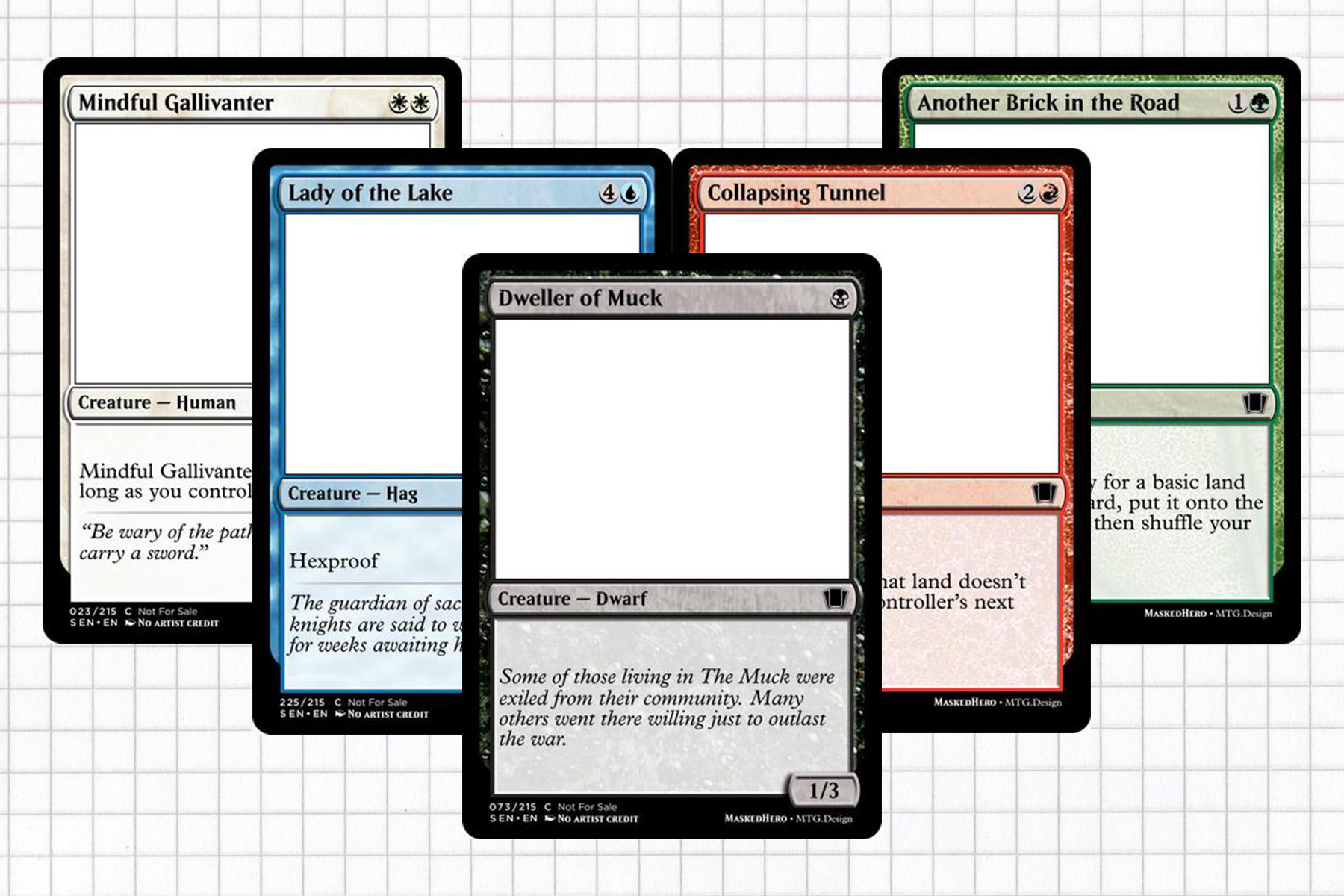
Every commons-only playtest went just about the same way. The decks are fun enough to theorycraft, I get a lot of great notes about what people like and don’t like, and the games often run at full speed into stalemates. In different iterations of the set at common, sometimes a game or match wouldn’t stalemate; that was almost always because something disproportionately broken had slipped through and I had no idea just how warping it was to the set outside of a vacuum. I now respect commons only playtesting—it will never be as rich as something like Pauper, but it certainly has it value.
Once higher rarity cards were introduced into playtesting, one of the pieces of feedback I took to heart was the lack of reasonable mana fixing. In some sets, I could see how that would be a feature and not a bug, pushing players to stick to a maximum of two-color decks. But for me, I wanted the games to be fun and for spells to be relatively splashable. That lead me to designing the enemy-colored rare lands and eventually the expanse lands getting basic land types to not only provide one instance of off-color mana but allow for synergy with the higher rarity cycle.
Designing Planeswalkers
Planeswalkers are a heck of a thing to design. This is not new to anyone who has spent time trying to build a planeswalker or set of planeswalkers that are meant to be balanced within their design. All three of my planeswalkers – Hans, Naarl-Aarl, and Gemeyes – were created purely from my imagination, with the intent that if the designs started to overlap with an established planeswalker, I would simply shift to that character. The designs started fairly early and have been an ongoing element of my design through all of the design process.
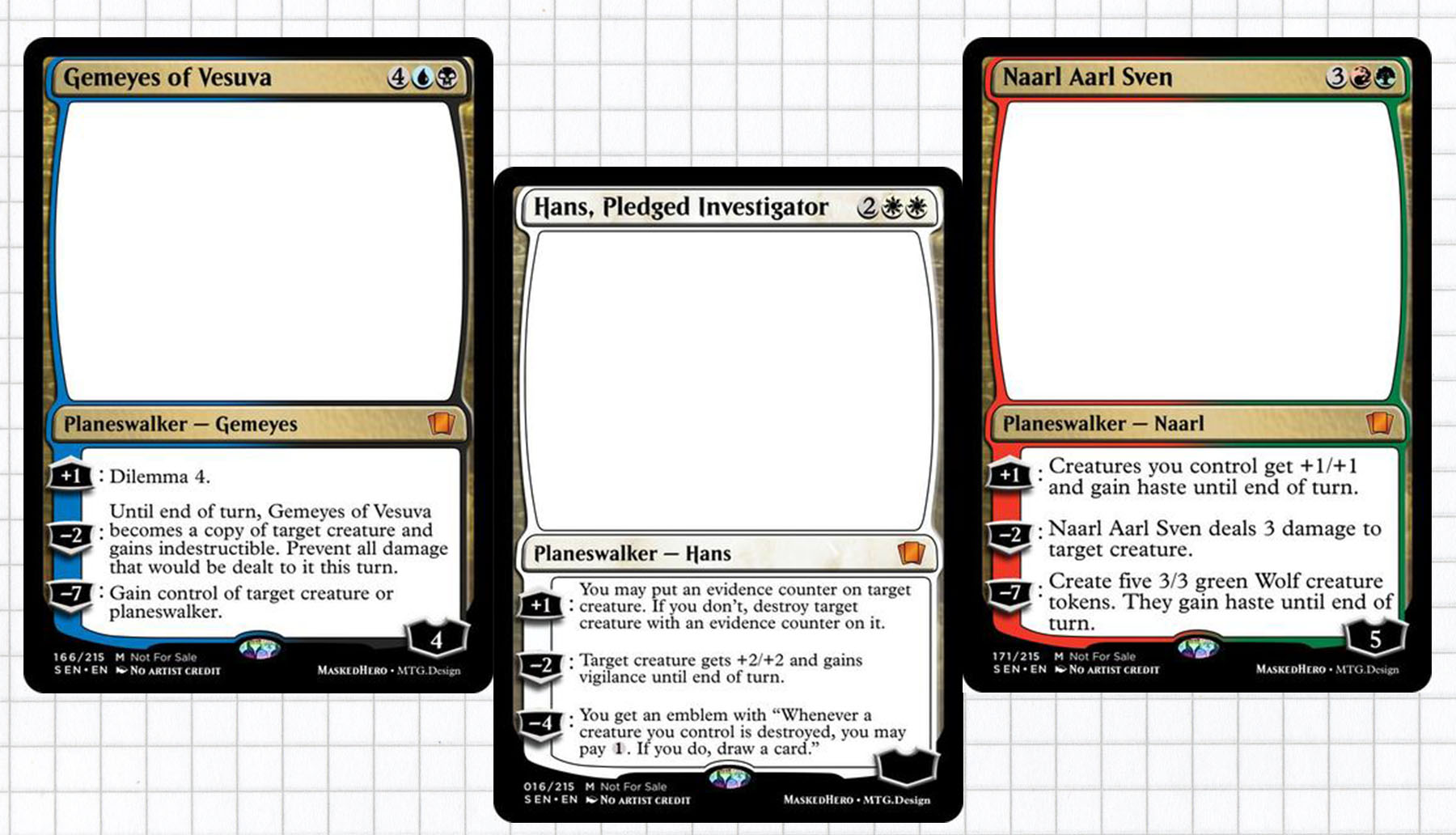
Hans came from taking my completely unfounded theory that the Hans mentioned in the flavor text of Lhurgoyf was actually a planeswalker. He was meant to play an investigative role, attracted to Sencora by the deaths of Yada and Talra that I discussed last week. Part of me always wanted Hans to come with a static ability, but the system I was using to build my set didn’t support that and so I had to work with what I had. With the design tool of static abilities on planeswalkers now being released to the public, I imagine that Hans will change to have a trigger ability that essentially makes him a planeswalker version of Murder Investigation or Bygone Bishop with two smaller abilities.
Naarl Aarl Sven has always been a half completed planeswalker design that was meant to be the finisher for a Red/Green deck, most powerful in the Wolves deck. He supports aggressive gameplay with his plus ability, protects himself with his minus and has proven to be a great finisher if he reaches his ultimate. While I like the card, I don’t think the abilities or the numbers are entirely set in stone at all with Naarl. He has become a piece that can be best evaluated once I completely understand what the strategy it supports needs.
My last planeswalker was originally meant to support the faerie tribal archetype as a control finisher. Over time they grew to become Gemeyes of Vesuva, a Dominarian planeswalker who explored a more radical design space. I wanted to see if it was possible for a planeswalker to be a meeting point between Clone and Sower of Temptation. In testing, a planeswalker that can become a creature like any of the Gideon planeswalkers with the added versatility of that body changing based on context has been pretty fun. The plus ability helping to find answers reads as a tad too powerful, but they represent enough of a threat that Impulse for six mana has played rather fair.
Going Public and Internal Struggles
Last Fall, I sat in on an episode of the Beacon of Creation podcast to talk about Age of Sencora as it had currently been designed. The experience was invaluable, as I was getting three more sets of eyes on the design. One of which was Alexis Janson, who herself had been apart of the design team for Lorwyn/Shadowmoor. At that time the set didn’t yet have Expanses and was utilizing a third mechanic that effectively made spells into split cards. Getting feedback on that execution, as well as some feedback on how Conform was fighting with the scarecrow theme (as they were just colorless artifacts at the time), I had gave me a much better picture of the future of my designs.
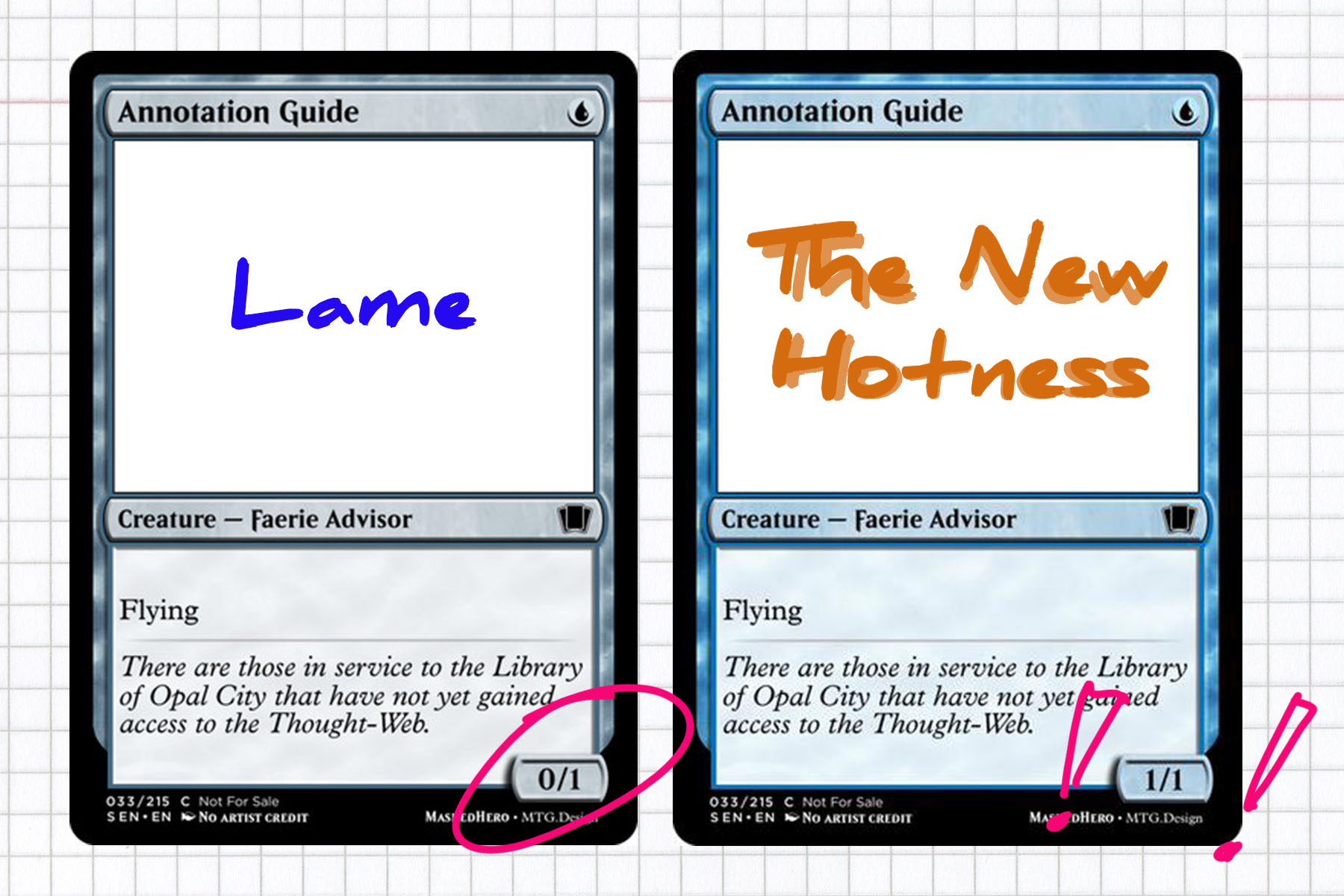
At present, with a lot of the larger pieces of the set where I want them, my current answer is to employ “two-brid” mana as a way to make them more attractive to the decks they would be best used in as scarecrow. They are also colored to interact with conform, but have some value to decks not in their color as pricier artifact creatures. This is all coming just before Mark Rosewater announced a few weeks ago that colored artifacts are going to become a more regular part of Magic. While I understand in a bigger picture how that is a good answer for Magic as a whole, for this set I wasn’t comfortable trying to adapt to that new paradigm.
With the feedback from Beacon of Creation, the removal of the not-exactly-split cards and the introduction of Expanse came from a want to refocus what the set was mechanically and trying to not split focus as to what areas—library, battlefield, exile—were important to track. By being lands that either improve spells in your hand or creatures in play, it became far less to track. The Expanses also helped to highlight a part of my worldbuilding that had slowly been getting chopped out as design was chugging along, a sense of beauty and wonder in this world that thematically drove the residences of Sencora to wander through the world.
Finding Balancing and Killing Darlings
One of the takeaways from my guest spot was that I had subconsciously created imbalances in some of my higher-rarity color distributions. This was partially due to having pet cards that fit into the same color combinations and not wanting to have the set to go to print without all of them. When building a set, it’s smart to essentially design a set and half of cards at a minimum during your first run through of design. But the issue I ran into was that I fell in love with too many cards that shared the same color pairings in my uncommons and rares. This meant either finding ways to shift some of the into other color pairs or retire them to hopefully use in a future design.
Outside of those designs, I tried very hard to make a cycle of enchantments based on Aesop’s Fables in the style of the Fate Reforged cycle of Khans/Dragon sieges. While I really liked the designs, several didn’t support any themes and were so complicated that playtesters really didn’t understand them. There was a point when Take Vengeance was in the set as removal for the Blue/White tap down deck; but because of how ruthless that deck played and how crowded two-drops became, I had to depower the archetype but switching the card slot to Vengeance. And maybe the most disappointing was never figuring out a proper build for The Fisher King and simply filling the set with cards referencing or quoting them.
The big takeaway from this entire process is the importance of understanding that the choices you make should be for the good a set. As fun as it sounds to build a set that has game altering cards in it, if the gameplay is too lopsided it can be no fun. I believe a lot of the design and development comes down to your own limitations as a designer, you build what you know and what you can plan for. If I had built a finisher like Psychatog into my set with nothing even close to competing with it, then games would come down to who opened and drafted that card.
A lot of the ideas you make will end up on the cutting room floor, but hopefully some of the can be recycled into other design in other sets. I have really enjoyed making this set and it has been a pleasure to finally get some of my internal dialogues out as well. Hopefully, I am in the final months of design and the set can be brought to an event in the near future.
Ryan Sainio is a Graphic Designer who writes about EDH and the EDH community. He has been playing Magic: The Gathering since 7th Edition in 2002 and values flavorful and fun gameplay over competitively optimized decks.

